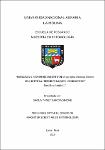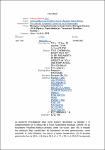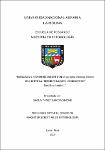Mostrar el registro sencillo del ítem
Biología y comportamiento de Anastrepha chiclayae Greene, 1934 (DIPTERA: Tephritidae) en "Corrocoto" Passiflora foetida L.
| dc.contributor.advisor | Narrea Cango, Mónica | |
| dc.contributor.author | García Sinche, Saola Yanet | |
| dc.date.accessioned | 2019-10-18T20:10:43Z | |
| dc.date.available | 2019-10-18T20:10:43Z | |
| dc.date.issued | 2019 | |
| dc.identifier.other | H10.G377-T BAN UNALM | |
| dc.identifier.uri | https://hdl.handle.net/20.500.12996/4143 | |
| dc.description | Universidad Nacional Agraria La Molina. Escuela de Posgrado. Maestría en Entomología | es_PE |
| dc.description.abstract | La presente investigación tuvo como objetivo determinar la biología y el comportamiento de la Mosca de la Fruta Anastrepha chiclayae Greene, en su hospedero Passiflora foetida conocido como "corrocoto", para ello el estudio fue realizado bajo condiciones de laboratorio en tres generaciones; como resultado el ciclo biológico, fue mayor a menor temperatura. En la primera generación fue de 38.0 ± 4.5 días a 24.5 ± 1.1 °C y 70.6 ± 3.2% HR; la segunda fue de 55.4 ± 1.7 días a 22.5 ± 0.4°C y 76.6 ± 2.7% HR y la tercera generación fue de 35.5 ± 1.3 días a 26.1 ± 0.4 °C y 69.0 ± 1.4 % HR; respectivamente el periodo de preoviposición fue de 19.7 ± 3.2, 18.2 ± 2.0 y 23.2 ± 3.6 días, la oviposición fue de 44.0 ± 10.3, 49.4 ± 6.5 y 59.8 ± 13.7 días y la capacidad de oviposición fue 130 ± 21.8, 144.6 ± 26.2 y 169.6 ± 59.2 huevos con un 93.9 % de viabilidad. La longevidad de los adultos apareados fue menor que los adultos no apareados, en hembras apareadas fue de 76.1, 87.7 y 91.3 días y en hembras no apareadas fue de 96.9, 135.8 y 127.2 días; en machos apareados fue de 94.2, 88.3 y 95.5 días y en machos no apareados fue de 124, 152.7 y 129.4. La eclosión del huevo ocurrió en 66.7 % por la tarde preferentemente desde las 15:00 a 18:00 horas, la larva abandonó el fruto para empupar en un 73 % por la mañana, preferentemente de 9:00 a 10:00 horas; la emergencia de los adultos preferentemente se dio en un 57 % en la mañana y su alimentación lo realizaron en horas luz desde las 8:00 a 14:00 horas; el comportamiento de cópula fue al vespertino, ocurriendo desde las 16:00 horas, con una duración de 50 a 182 minutos; la oviposición lo realizó en la mañana, preferentemente de 8:00 a 12:00 horas y ovipositando mayormente grupo de tres huevecillos. Los factores de temperatura, humedad, disponibilidad del hospedero, viabilidad de huevos, duración del periodo de oviposición y longevidad determinarían que Anastrepha chiclayae tenga considerables poblaciones y se encuentre presente todo el año. | es_PE |
| dc.description.abstract | The objective of this research was to determine the biology and reproductive behavior of the Fruit Fly Anastrepha chiclayae Greene, on a host plant named "corrocoto" Passiflora foetida L., a Passion Flower, under laboratory conditions and for three generations. As a result, the biological cycle took a longer time at lower temperature than at higher experimental temperature level: in the first generation it took 38.0 ± 4.5 days at 24.5 ± 1.1 ° C, and 70.6 ± 3.2 % RH; in the second was 55.4 ± 1.7 days at 22.5 ± 0.4 ° C, and 76.6 ± 2.7 % RH; and in the third generation it was 35.5 ± 1.3 days at 26.1 ± 0.4 ° C, and 69.0 ± 1.4 % RH; respectively the duration of the pre oviposition periods were 19.7 ± 3.2, 18.2 ± 2.0, and 23.2 ± 3.6 days; the oviposition periods were 44.0 ± 10.3, 49.4 ± 6.5, and 59.8 ± 13.7 days, and the total ability to oviposit were 130 ± 21.8, 144.6 ± 26.2, and 169.6 ± 59.2 eggs, with an average of 93.9 % of viability. The longevity of the mated adults was lower than the unpaired: in mated females were 76.1, 87.7, and 91.3 days, and in unpaired females were 96.9, 135.8 and, 127.2 days; in mated males were 94.2, 88.3, and 95.5 days while in unpaired males it were 124, 152.7, and 129.4 days. Egg eclosion occurred in 66.7 % during the afternoon, preferably from 15:00 to 18:00 hours; in the morning 73 % of the larvae abandoned the fruit to pupate preferably from 9:00 a.m. to 10:00 hours, and besides 57 %, the adult emergence; and their feeding was performed in light hours from 8:00 a.m. to 2:00 p.m; copulation a occurred at sunset, occurring from 16:00 hours, with a duration of 50 to 182 minutes; and the period of oviposition occurred in the morning preferably from 8:00 to 12:00 hour, and the oviposition mostly group of three eggs. Factors such as a temperature, humidity, host availability, the viability of eggs, duration of the period of oviposition, and the longevity would explain why A. chiclayae reach considerable field populations and is present throughout the year. | en_US |
| dc.description.uri | Tesis | es_PE |
| dc.format | application/pdf | en_US |
| dc.language.iso | spa | es_PE |
| dc.publisher | Universidad Nacional Agraria La Molina | es_PE |
| dc.rights | info:eu-repo/semantics/restrictedAccess | en_US |
| dc.rights.uri | https://creativecommons.org/licenses/by-nc-nd/4.0/ | * |
| dc.source | Universidad Nacional Agraria La Molina | es_PE |
| dc.source | Repositorio institucional - UNALM | es_PE |
| dc.subject | Passiflora | es_PE |
| dc.subject | Anastrepha | es_PE |
| dc.subject | Organismos indígenos | es_PE |
| dc.subject | Biología animal | es_PE |
| dc.subject | Comportamiento animal | es_PE |
| dc.subject | Evaluación | es_PE |
| dc.subject | Perú | es_PE |
| dc.subject | Passiflora foetida | es_PE |
| dc.subject | Maracuya silvestre | es_PE |
| dc.subject | Corrocoto | es_PE |
| dc.title | Biología y comportamiento de Anastrepha chiclayae Greene, 1934 (DIPTERA: Tephritidae) en "Corrocoto" Passiflora foetida L. | es_PE |
| dc.type | info:eu-repo/semantics/masterThesis | en_US |
| thesis.degree.discipline | Entomología | es_PE |
| thesis.degree.grantor | Universidad Nacional Agraria La Molina. Escuela de Posgrado | es_PE |
| thesis.degree.name | Magister Scientiae - Entomología | es_PE |
| thesis.degree.level | Maestría | es_PE |
| dc.subject.ocde | https://purl.org/pe-repo/ocde/ford#1.06.11 | es_PE |
Ficheros en el ítem
Este ítem aparece en la(s) siguiente(s) colección(ones)
-
M-ENT Tesis [21]





